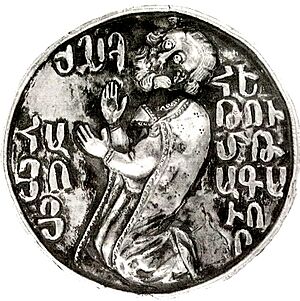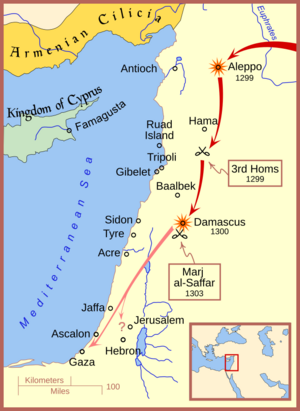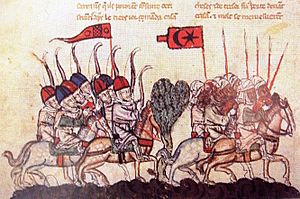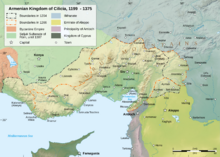Hethum II facts for kids
Quick facts for kids Hethum II |
|
|---|---|
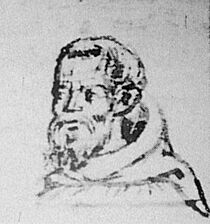
King Hethum II, in Franciscan gown
|
|
| King of Cilician Armenia (1st reign) | |
| Reign | 1289–1293 |
| Predecessor | Leo II |
| Successor | Thoros III |
| King of Cilician Armenia (2nd reign) | |
| Reign | 1295–1296 |
| Predecessor | Thoros III |
| Successor | Sempad |
| Co-ruler | Thoros III |
| King of Cilician Armenia (3rd reign) | |
| Reign | 1299–1303 |
| Predecessor | Constantine I |
| Successor | Leo III |
| Regent of Cilician Armenia | |
| Regency | 1303–1307 |
| Monarch | Leo III |
| Born | 1266 |
| Died | November 17, 1307 (aged 40–41) Anazarbus |
| Dynasty | Hethumids |
| Father | Leo II |
| Mother | Keran of Lampron |
| Religion | Armenian Church |
Hethum II (Armenian: Հեթում Բ; 1266 – November 17, 1307) was a king of the Armenian Kingdom of Cilicia. He ruled at different times between 1289 and 1303. During his time, Armenia was under the control of the powerful Mongol Empire.
Hethum II gave up his throne twice to become a Franciscan monk. Even as a monk, he remained very important in the kingdom's politics. He was known as the "Grand Baron of Armenia" and later as a Regent for his nephew. Hethum was the son of Leo II of Armenia and Kyranna de Lampron. He belonged to the Hethumid dynasty. His grandfather, Hethum I, had made Cilicia a subject of the Mongols in 1247. Hethum II and his nephew, Leo III, were killed by a Mongol general named Bilarghu. Bilarghu was later executed for this crime by the Mongol ruler Öljaitü.
First Time as King
Since 1247, Cilician Armenia had been a state that paid tribute to the Mongol Empire. This agreement was made by Hethum II's grandfather, Hethum I. Because of this, Cilician Armenia often sent soldiers to help the Mongols. They fought together against the Mamluks and other Islamic groups.
Hethum II became king in 1289 when his father, Leo II, passed away. Hethum was in his early twenties. At this time, Cilician Armenia was in a difficult spot. It had to balance friendships with Christian Europeans and the Byzantine Empire. It also faced attacks from the Turkish Sultanate of Rum to the west. To the east, it was a subject of the strong Mongol Empire. From the south, it had to defend against attacks from the Muslim Mamluks of Egypt. The Crusades were ending, and Islamic forces were taking back lands from the Crusaders. They were also pushing back against the Mongols.
In 1289, some Spiritual Franciscans arrived in Armenia. They wanted to share their Christian faith with the Armenian Christians. These Franciscans had been jailed in Italy for speaking out against luxury in the church. However, they were welcomed by the Armenian court. Hethum sent St Thomas of Tolentino to Rome, Paris, and London. He asked for another crusade to help the Armenians, but this did not happen. Still, St. Thomas returned with more religious leaders. They supported the mission and hoped to unite the Armenian Church with the Roman Catholic Church.
In 1292, Khalil, the Mamluk sultan of Egypt, attacked Cilician Armenia. His father, Qalawun, had broken a peace treaty earlier. Khalil's forces had already conquered the Kingdom of Jerusalem in 1291. They continued their advance, attacking the Armenian city of Hromgla. Hromgla was defended by Hethum's uncle, Raymond, but it fell after a 33-day siege. To stop more invasions, Hethum II gave up the cities of Marash, Behesni, and Tel Hamdoun to the Mamluks.
In 1293, Hethum decided to step down as king. He gave the throne to his brother, Thoros III. Hethum then joined the Franciscan monastery at Mamistra. Even as a monk, he stayed involved in the kingdom's affairs. He talked with the Egyptian leader Ketbougha to get back prisoners from Hromgla. He also worked to get back some church treasures that had been stolen.
Second Time as King
In 1295, Thoros III asked Hethum to become king again. Thoros wanted Hethum to help renew their alliance with the Mongols. Hethum made a long trip to the Mongol capital. He successfully asked the Mongols for their help. When he returned to Armenia in 1296, there was more good news. The Byzantine Empire offered a marriage alliance.
Hethum and Thoros put their brother Sempad in charge of Armenia. They then traveled to Constantinople to arrange for their sister, Rita, to marry the Byzantine Emperor Michael IX Palaeologus. However, while they were away, Sempad took the Armenian throne for himself. He had help from another brother, Constantine. Hethum and Thoros were captured in Caesarea when they returned. They were imprisoned in the fortress of Partzerpert. There, Hethum was partly blinded. Thoros was killed in Partzerpert in 1298. But then Constantine turned against Sempad. He took the throne for himself, imprisoned Sempad, and freed Hethum.
Third Time as King
In 1299, Hethum had recovered some of his sight. He removed Constantine from power and became king again. Soon after, he again asked for help from Ghazan's Mongols. They fought against the Mamluks in Syria. Their combined forces won a big victory in December 1299 at the Battle of Wadi al-Khazandar (also called the Battle of Homs). They took Damascus. Hethum was able to get back all the Armenian land that had been lost to the Mamluks. One group of Mongols even went as far south as Gaza, pushing the Mamluk troops back to Egypt.
Some stories say that Hethum may have visited Jerusalem in 1300 during this time. However, historians are not sure if this visit actually happened. The Mongols later went back north, and the Mamluks easily took back Palestine.
Hethum's gains against the Mamluks did not last long. In 1303, the Mamluks attacked again from Egypt. The Armenians joined forces with a large number of Mongol troops. But they were defeated in two battles in Syria in March and April 1303. This campaign was the last major Mongol invasion of Syria. Hethum went back to Ghazan's court. He then gave up his crown again. His brother Thoros III had been killed in 1298. So, Hethum passed the crown to Thoros's young son, Leo III. Hethum went back to a monastery. However, since Leo was not yet an adult, Hethum remained the Regent of Armenia.
Later Years
In 1304, the Mamluks continued their attacks on Cilician Armenia. They took back all the lands the Armenians had gained during the Mongol invasion. The Mamluks wanted to punish the Armenians for working with the Mongols.
The Armenian Kingdom of Cilicia continued its alliance with the Mongol Empire. They needed protection from the Seljuk Sultanate of Rûm to their west. They also hoped to gain land to the east, even if it was for a short time. After the Mongol ruler Ghazan became Muslim in 1295, his successor Öljaitü had less control over distant lands. He also reduced military campaigns against the Mamluks in Syria.
One of Öljaitü's generals, Bilarghu, was a strong Muslim. He wanted to build a mosque in the city of Sis. Sis was still part of the Christian Kingdom of Armenia. This might have been part of a plan to take control of the area. Hethum wrote a letter to Öljaitü, sharing his worries about these plans.
Bilarghu then called Hethum to a meeting on November 17, 1307. The meeting was at a camp near the royal fortress of Anazarbus. Hethum went with about 40 noblemen and his young nephew, King Leon. Hethum was acting as Regent for Leo. However, Bilarghu had learned about Hethum's letter. He ordered his men to kill the Armenian king and his guests when they arrived. The Armenians were massacred while they were eating, along with Hethum and King Leon.
After this terrible event, Hethum's brother, Oshin, became the heir to the throne. He took control of Sis. Oshin sent another brother, Alinakh, to tell Öljaitü about Bilarghu's betrayal. Öljaitü ordered Bilarghu and his soldiers to be executed right away. He also confirmed his support for Oshin as the new king. Leo III had no children because he was too young to marry when he was killed.


